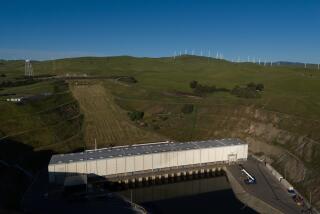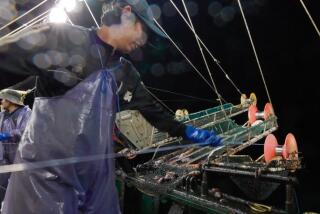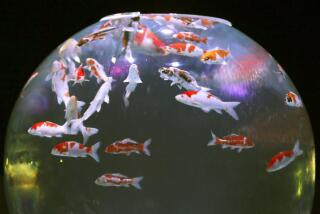FOCUS : Japanese Argue Against Ban on Drift Nets
TOKYO — Japan’s voracious appetite for seafood is making waves once again as the world moves closer to a ban on fishing with drift nets.
Officials of the Japanese fishing industry claim that the environmental effects of the nets are exaggerated by “emotional” conservationists in the United States.
Opponents have described drift nets as “curtains of death,” a kind of maritime strip mining that kills all life in its path, including marine mammals and sea birds.
In Japan, however, “we see absolutely no reason for this to be prohibited,” said Toru Morikawa of the Japan Fisheries Assn.
“We have been vastly misrepresented,” said Koji Imura, chairman of the Japan Squid Driftnet Fishery Assn.
Japan’s drift-net fishing industry consists of about 400 ships and 10,000 fishermen. Most operate in the North Pacific in search of squid, a common food in Japan.
They run lines of 10 or more drift nets. The nets are 2 to 3 miles long and are placed at least a half a mile apart, Imura said.
A total ban on their use would cost thousands of fishermen their jobs and seriously damage squid-processing companies, he said, estimating the total loss at about $770 million a year.
In 1990, 10% of the drift-net ships killed 1,758 whales and dolphins, 30,464 sea birds, 253,288 tuna, 81,956 blue sharks and more than 3 million other fish they were not trying to catch, according to a U.S. government study.
The Japanese fishing industry argues that more studies are needed to determine whether drift nets cause excessive destruction.
“High-seas drift-net fishing, like other fishing methods, can be managed under appropriate conservation and management methods,” including subsurface nets that do not harm birds, the fisheries association said in a statement.
It said the U.S. position ignores American shark drift nets and salmon gill nets used off California, which the association holds responsible for drowning thousands of sea lions every year.
The issue is to be taken up in November at the United Nations, which already has voted to ban environmentally destructive nets next summer. Its resolution would allow the continued use of drift nets if safety measures were taken.
American critics of drift nets say the U.N. resolution, which Japan supported, is too weak.
Janet Mullins, an assistant secretary of state, said in September that the United States will make a “major diplomatic effort” to achieve a permanent ban on large-scale drift nets by July, 1992.
The Senate has approved a bill that would require the President to impose trade sanctions on countries that use drift nets after June 30, 1992. Besides Japan, Taiwan and South Korea are the main users of drift nets.
In October, President Bush postponed for 90 days a decision on whether to impose sanctions on Taiwan and South Korea for illegal fishing with drift nets.
Many Japanese see the U.S. activity against drift nets as political revenge for Japan’s huge trade surplus, and they argue that American meat-eaters have no right to trample on Japan’s preference for fish.
The average Japanese eats 80 pounds of seafood a year, compared to 15 pounds for an American.
“From time immemorial, the people of Japan have depended heavily on marine resources for food and have developed their own unique food culture,” Morikawa said. “Such a historical background cannot be abruptly eradicated.”
Concern for Japan’s food culture was fanned in September when the United States considered seeking protection for bluefin tuna under the Washington Convention, which regulates international trade in endangered species.
Commercial Fishing’s ‘Curtain of Death’
Japan, with a fleet of 400 ships and 100,000 fishermen, opposes efforts by the international community to ban drift nets from high seas. Opponents to drift nets say the nets indiscriminately kill all life in their path, including marine mammals and sea birds. A study conducted by the U.S. Government last year found that just 10% of Japan’s drift net fleet killed 1,758 whales and dolphins, 253,288 tuna, 81,956 blue sharks, 30,464 sea birds and more than 3 million other non-targeted fish.
Drift net: Floats like a curtain in the water. The net is shot across the expected path of the schools of fish, which are caught by the gills as they try to swim through. Each net section is called a Tan and is about 2 miles long. The net is held in a vertical position by floats and weights. Length: up to 30 miles. Depth: about 24 feet. Fish targeted: squid, herring
Victims of the net: marlin, ocean sunfish, porpoise, salmon, sperm whale, albatross, shark, tuna, ray, mackerel, loggerhead turtle
Source: National Marine Fisheries Service, Random House Encyclopedia
More to Read
Sign up for Essential California
The most important California stories and recommendations in your inbox every morning.
You may occasionally receive promotional content from the Los Angeles Times.










